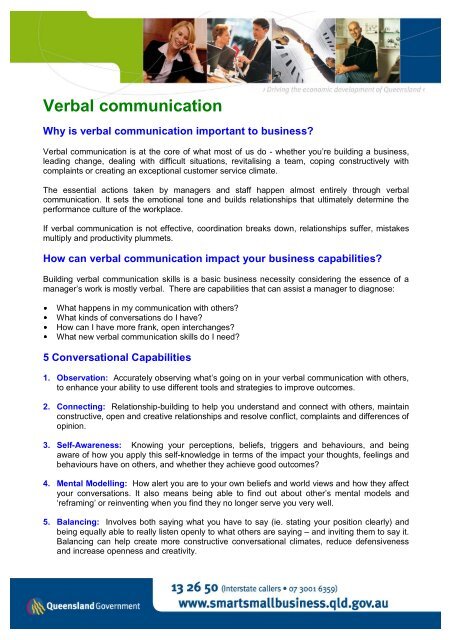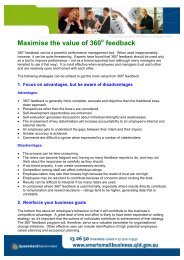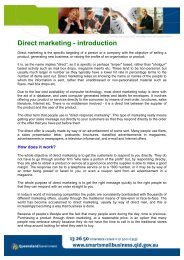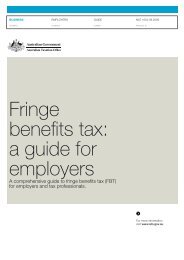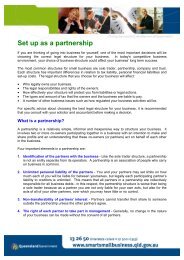Verbal communication - AJML Group
Verbal communication - AJML Group
Verbal communication - AJML Group
You also want an ePaper? Increase the reach of your titles
YUMPU automatically turns print PDFs into web optimized ePapers that Google loves.
<strong>Verbal</strong> <strong>communication</strong><br />
Why is verbal <strong>communication</strong> important to business?<br />
<strong>Verbal</strong> <strong>communication</strong> is at the core of what most of us do - whether you’re building a business,<br />
leading change, dealing with difficult situations, revitalising a team, coping constructively with<br />
complaints or creating an exceptional customer service climate.<br />
The essential actions taken by managers and staff happen almost entirely through verbal<br />
<strong>communication</strong>. It sets the emotional tone and builds relationships that ultimately determine the<br />
performance culture of the workplace.<br />
If verbal <strong>communication</strong> is not effective, coordination breaks down, relationships suffer, mistakes<br />
multiply and productivity plummets.<br />
How can verbal <strong>communication</strong> impact your business capabilities?<br />
Building verbal <strong>communication</strong> skills is a basic business necessity considering the essence of a<br />
manager’s work is mostly verbal. There are capabilities that can assist a manager to diagnose:<br />
y<br />
y<br />
y<br />
y<br />
What happens in my <strong>communication</strong> with others?<br />
What kinds of conversations do I have?<br />
How can I have more frank, open interchanges?<br />
What new verbal <strong>communication</strong> skills do I need?<br />
5 Conversational Capabilities<br />
1. Observation: Accurately observing what’s going on in your verbal <strong>communication</strong> with others,<br />
to enhance your ability to use different tools and strategies to improve outcomes.<br />
2. Connecting: Relationship-building to help you understand and connect with others, maintain<br />
constructive, open and creative relationships and resolve conflict, complaints and differences of<br />
opinion.<br />
3. Self-Awareness: Knowing your perceptions, beliefs, triggers and behaviours, and being<br />
aware of how you apply this self-knowledge in terms of the impact your thoughts, feelings and<br />
behaviours have on others, and whether they achieve good outcomes?<br />
4. Mental Modelling: How alert you are to your own beliefs and world views and how they affect<br />
your conversations. It also means being able to find out about other’s mental models and<br />
‘reframing’ or reinventing when you find they no longer serve you very well.<br />
5. Balancing: Involves both saying what you have to say (ie. stating your position clearly) and<br />
being equally able to really listen openly to what others are saying – and inviting them to say it.<br />
Balancing can help create more constructive conversational climates, reduce defensiveness<br />
and increase openness and creativity.
Types of verbal <strong>communication</strong><br />
Understanding these different modes of group discussion and their protocols provides a powerful<br />
verbal <strong>communication</strong> coaching tool.<br />
1. Debate is what we see most of in conventional conversation: ‘I put up my point of view, you put<br />
up yours - and we try to knock each other out’. This is an inappropriate style if what you want<br />
is meaningful interaction. Constructive <strong>communication</strong> is productive dialogue and skillful<br />
discussions where new insights can emerge through healthy give and take.<br />
2. Discussion focuses on decisions and actions. I may still want to see my view prevail, but<br />
there’s some concession to listen to other’s viewpoints, exchange facts and opinions and<br />
perhaps even alter my position as a result. In terms of our conversational continuum, polite<br />
discussion is different to skillful discussion. Polite discussion is really a veiled version of<br />
debate. It’s ‘polite’ only insofar as conflict, controversy and ‘hard-to-handle’ issues are kept<br />
concealed under the surface. Polite discussion is actually anything but. It’s riddled with hidden<br />
agendas, ‘corridor talk’, secret lobbying, dissembling, manipulation, factionalism and thinly<br />
veiled competition.<br />
3. Dialogue is designed to promote a free-flowing interchange of ideas and create an open, equal<br />
and collaborative conversational climate. In dialogue:<br />
y<br />
y<br />
y<br />
The ‘point’ of the conversation is to share perspectives and understandings;<br />
People talk together to find meanings and develop new ideas and concepts - feeding off<br />
each other’s contributions;<br />
The purpose is to go past the understanding of individual team members - to explore issues<br />
creatively from many points of view.<br />
Further information<br />
The following fact sheets provide further information on these issues:<br />
• Change management<br />
• Business <strong>communication</strong>s<br />
• Effective work teams<br />
• Help groups make decisions<br />
• Improve your interviewing skills<br />
• Manage conflict<br />
• <strong>Verbal</strong> <strong>communication</strong> – how to communicate effectively


